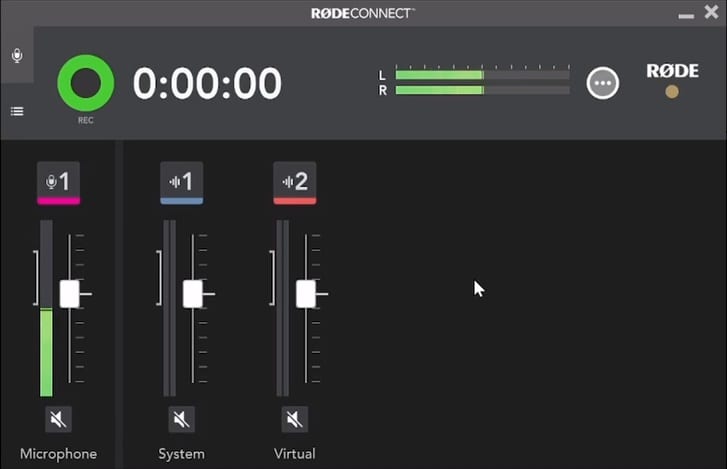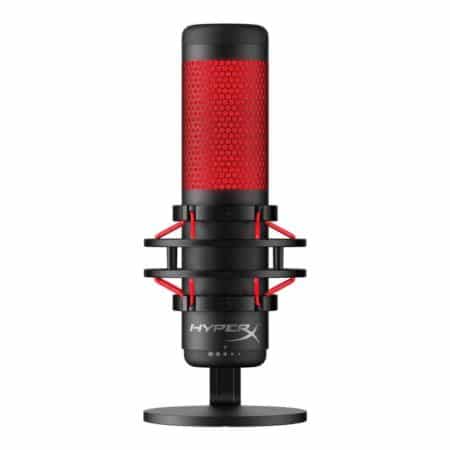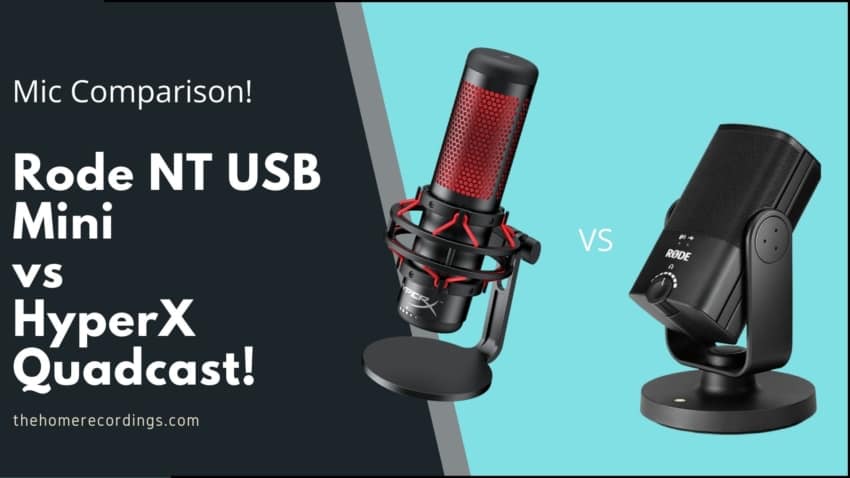Last updated on December 29th, 2023 at 09:53 pm
The Rode NT USB Mini is a relatively new microphone that sells for less than $100 and that comes with an interesting and useful software. The HyperX Quadcast has been around for much longer and is a bit more expensive, but which one is actually the better microphone?
In this article, I will be comparing both microphones, going over how they sound, their build quality, what they are good for, their included software, and more.
So, without any further ado, let’s get started!
In short, here are the differences between the Rode NT USB Mini and the HyperX Quadcast: Both are condenser microphones but the HyperX Quadcast features four polar patterns to the Rode’s one. However, the Rode NT USB Mini has a better sound overall and it comes with the Rode Connect software which is designed to let you process the signal further.
So, let’s get this show on the road, shall we?
Rode NT-USB Mini Overview

The Rode NT USB Mini is the little brother of the Rode NT USB, and it comes with the same feature set but at a much lower price tag. However, I don’t think that it sounds as full, but more on this in a second.
As far as the build quality goes, everything but the grille is excellent, since the grille does flex a little more than the one on the Rode NT USB (the big one), but it’s definitely not enough for me to worry about it getting damaged.
It features one knob on the front that lets you control the headphone volume and that also allows you to enable zero-latency monitoring when tapping on it. A light on top of the knob will turn on indicating that zero-latency monitoring is enabled (the second light only tells you if the mic is connected and getting power).
It comes with a 360-degree swing mount that is great for setting up the mic on a boom arm since you can turn it however you want until you get it just right.
Contrary to its bigger brother, the NT USB Mini doesn’t come with an included pop filter, but rather has one already built-in, although I have to say that plosives are still kind of an issue and I would recommend using an external pop filter just in case.
Now, you may have noticed that it only has one knob, which is the one that controls the headphone volume, but where are the gain and Mix knobs? Well, there are none, which is a shame, and you need to control both of these functions from your PC.
I through Rode would’ve learned after not including a gain dial on the NT USB, but they actually went further and removed one more knob.
It’s worth mentioning, however, that even though it would be nice to have dedicated knobs to control the gain and the mix between the computer’s playback and the direct signal, all of this can easily be adjusted through their Rode Connect software.

The Rode Connect software lets you use up to 4 Rode NT USB Minis one a single computer, access some processing which are built into the mic, such as a gate, compression, and more, and it also lets you control the playback volume of different apps and games, which lets you create a nice mix for your stream (great software for gamers).
Lastly, it doesn’t come with a shock mount, and when using it with the included desk stand, it will absolutely pick up all the keyboard strokes, tapping on the desk, or any other types of vibrations that may be present. So, for all you gamers out there, get a boom arm!
What comes in the Box?
- Rode NT USB Mini Microphone
- Desktop Stand
- Microphone Stand adapter
- UNB Cable
Features
- Comes with the Rode Connect Software (Great for streamers & gamers)
- Built-in pop filter.
How does it sound?
The Rode NT USB Mini offers a very balanced sound, especially when recording voice-related stuff and singing: The low end isn’t too prominent or boomy while still being extremely present, the mids are actually quite prominent but I like how this affects the vocals, and the high end is very open and airy without sounding shrill.
So, at least as far as vocals goes, it’s a very balanced sound, and I though the same when recording my acoustic guitar since there was nothing really standing out to me as overly harsh.
The one con I can think of is that, since the mid frequencies are a bit more prominent than in other mics, people who have a very nasally voice might find that that nasally sound will be slightly exaggerated.
Lastly, when recording my electric guitar, it sounded great when recording a clean signal, but I didn’t really like recording distorted guitars with it since it made them sound quite shrill.
And lastly, the headphone amp that the Mini comes with is great: It has enough power to drive the Sennheiser HD 650!
Specifications
- Polar Pattern; Cardioid
- Frequency Response: 20Hz- 20kHz
- Sample Rate: 48kHz/24-bit
- Max SPL: 121dB
- Weight: 585g
Get the Rode NT USB MINI here.
- Rode NT USB MINI: Amazon, Sweetwater.
HyperX Quadcast

So, firstly, this microphone is clearly aimed towards gamers who want to stream their gameplay, or just YouTubers in general, because of the way it looks.
Of course, it can be used to do almost anything since it’s a very versatile microphone, but even though I like its appearance, it’s definitely not as professional-looking as some other microphones, including the Samson NT USB mini.
The HyperX Quadcast is a condenser microphone that comes with the following pickup patterns: Cardioid-, Omni-, Bi-directional-, and stereo patterns, which make it quite versatile, similar to the Blue Yeti (It’s clearly a copy of the Blue Yeti). Although it’s worth mentioning that most people will be using the cardioid pattern 99% of the time.
It comes attached to a desk-stand that also has a built-in shock mount, and this is definitely a really nice bonus to have since it will either completely avoid picking up unwanted vibrations coming from the desk, or at least reduce them significantly.
Note: The Rode NT USB Mini doesn’t come with a built-in shock mount which is actually quite the problem, but more on that later.
On the back of the microphone you’ll have access to the USB connection and to a headphone jack that lets you do zero-latency monitoring.
Once the microphone is connected and working, it will light up in a really nice red color (I used to think that this was the color of the microphone itself, but it’s actually thanks to the internal lighting).
On the top of the microphone you’ll find a touch-sensitive “Mute” button; When the mic is muted, the background light inside the microphone will turn off.
This is a really nice feature to have for two reasons; Most USB microphones don’t have this option and you need to turn the Gain dial all the way down if you want to mute it, and getting the exact same level afterwards can be tricky. This way you only need to unmute it and you’re back recording at the exact same level.
The other reason is that since the microphone only lights up when it is recording, you’ll have visual feedback when it’s muted or not.
Now, I mentioned that it comes with four different pickup patterns, and while they all may have their place, you’re probably going to be using the cardioid one the most, especially if you’re doing voice-over, singing, Streaming, etc. since it’s designed to only pick up what is right in front of the mic.
The Omni polar pattern is designed to record everything surrounding it, and if you want to do a podcast and only have this microphone, then this would be the polar pattern of choice.
Lastly, the Stereo and Bi-directional patterns are identical, with the only difference being that the bi-directional picks up sound from the front and back, while Stereo picks up sound from both sides (they work a little differently, however).
If you’re interviewing someone, then Bi-directional is the best one, while if you want to record and acoustic guitar for example, stereo would be best because it used two capsules and creates a nice stereo effect.
What comes in the Box?
- The HyperX Quadcast Microphone
- USB Cable
- Mic Stand adapter
Features
- Tri-capsule array: three condenser capsules inside
- Multiple pattern selection: cardioid, stereo, omnidirectional and bidirectional
- Gain control, mute button, zero-latency headphone output
- Good for podcasting, voiceovers, game streaming, interviews and conference calls
- Plug ‘n play: Mac and PC compatible
- Desk stand included (already attached to the mic)
- Mic-Stand adapter (may hurt the cables)
How does it Sound?
For spoken word, voice over, streaming, etc. I found it to be a good microphone; it sounds full and I needed to do little-to-no editing after the recording was done in order to get a professional sound out of it.
For music, on the other hand, I don’t recommend it.
I recorded my acoustic guitar with it and the Stereo Pattern did work quite well, even though it lacked a bit of oomph in the lower end.
With the Cardioid pattern however, it sounded way too boomy for my taste, which is kind of the opposite of what happened with the stereo pattern.
Another issue I found was with the built-in pop filter which is designed to reduce unwanted plosives when you’re talking; It is definitely far from the best and if you’re going to be speaking straight into the microphone, then I’d highly recommend purchasing an external pop filter, otherwise get ready to re-record everything multiple times.
One other issue popped up when I mounted it on a regular mic-stand using the adapter; there’s little to no room between the mic and the mic-stand and this creates unnecessary pressure on both the USB- and headphone cables…
So, imagine how long those cables will last… Not to mention the USB and headphone connectors themselves.
Now, one huge pro of this microphone is the “Mute” button on the top, which is something I wish more USB microphones would feature, and also that it comes with a shock mount, so yes, there are some really good things that HyperX did right here.
Lastly, this microphone is marketed towards gamers mostly, so why on earth does it need four polar patterns? You only need a Cardioid one as a gamer/streamer and the cost could’ve been significantly lower if they didn’t include the extra three.
This is definitely a con, but some people may use those extra patterns sometime.
Specifications
- Polar Pattern; Cardioid, stereo, omni- and bidirectional
- Frequency Response: 20Hz- 20kHz
- Sample Rate: 48kHz/16-bit
- Sensitivity: -36dB
- Weight: 254g
You can get the HyperX Quadcast here.
Which one should you go for?
These two microphones are completely different and serve different purposes (because of the HyperX’s four polar patterns). Although, it’s worth noting that you will be using the cardioid pattern 99% of the time unless you’re using the stereo pattern to record music, or the omni/bidirectional ones to record a podcast.
If you’re only going to be using the cardioid pattern, then go with the Rode NT USB Mini. Not only does it sound a lot better but it also sells for a lot less, plus it’s quite smaller than the HyperX.
The only reason I would go with the HyperX Quadcast is if I really need a multi-polar microphone, but that’s really the only reason and the truth is that you should go with the Blue Yeti in that case.
Still, I believe that the Rode wins overall because of the lower price tag.
Other alternatives
I reviewed a couple USB mics already and there are two that stand out: The Audio-Technica AT2020+ USB, the Elgato Wave 3 and the Samson G-Track Pro.
The AT2020+ USB sounds great, similar to the Elgato Wave 3 in my opinion, but it’s completely made out of metal, so there’s that, but it doesn’t come with the included software, so I don’t think it’s as good for streamers.
The Elgato Wave 3 comes with a software specifically designed for streamers since it allows you to set up a limiter to prevent volume spikes, a high-pass filter to lower the proximity effect, and it also lets you control the volume of all the different apps you’re streaming to create a good mix. So, if you’re a gamer/streamer, this one might be a good choice.
The Samson G-Track Pro is an interesting alternative, mainly for guitarists and bassists since it features an instrument jack that lets you record both the microphone signal and the instrument signal to separate tracks, and you can even use it with amp simulation software with very low latency.
Conclusion
The Rode NT USB Mini is far better than the HyperX Quadcast in my humble opinion: It’s far cheaper, it only has one polar pattern but records much better with it than the HyperX (it could be considered a “one-trick pony” instead of a “jack of all trades”, like the HyperX.
Additionally, it comes with the Rode Connect software which is great for streaming & gaming.
